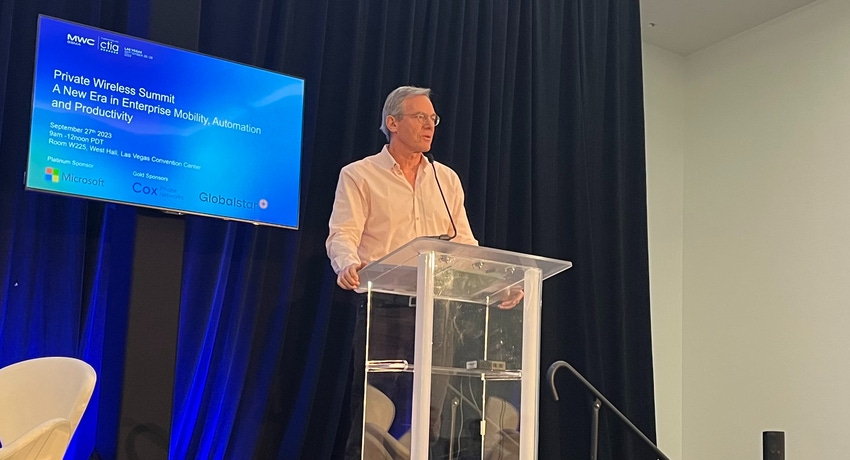Globalstar touts XCOM RAN deal with 'large global retailer'
Globalstar said its new XCOM RAN offering can handle four times the traffic of traditional 5G networks. And the company touted a big, unnamed customer.

Days ahead of the MWC Barcelona trade show, Globalstar unveiled its new XCOM RAN offering, a wireless networking product that the company said can handle four times the traffic of traditional 5G networks in indoor venues like stadiums and warehouses. The company also teased that its "first commercial sale is with one of the world's largest retailers."
Company officials did not name the retailer. According to the National Retail Federation, some of the world's biggest retailers include Walmart, Amazon, Costco, Carrefour and Home Depot.
Importantly, Globalstar enlisted Signals Research Group (SRG) to test its XCOM RAN system. SRG is a third-party network testing company that has offered independent, unbiased assessments of cutting-edge technologies from the likes of Dish Network, T-Mobile and Qualcomm.
In its 31-page report, SRG said Globalstar's new technology "delivered very high downlink and uplink capacity due to high reuse of nearly all resource blocks on each MIMO layer." The firm said it conducted its tests at a facility in California.
"Average downlink capacity reached over 4.5 Gbps in 100 MHz of TDD spectrum (64.6 bps/Hz) while in the uplink we documented an average throughput of nearly 770 Mbps (38.3 bps/Hz) with a spectrum allocation that was biased toward the downlink direction," the firm continued. "High reuse of network resources – up to 16 downlink MIMO layers and up to 12 uplink MIMO layers with nearly full reuse of all resource blocks (RBs) on each layer – largely explains the observed gains. Even more MIMO layers are possible in one or both directions depending on the network configuration and device capabilities."
Globalstar said its XCOM RAN technology can process signals at the edge, thereby eliminating handoff boundaries and interference conditions and creating more overall network capacity in dense, high-traffic areas. That represents a change from 5G and Wi-Fi systems that generally lose capacity due to interference and handovers in such locations.
The wider context
Globalstar said its XCOM RAN adheres to 5G specifications from the 3GPP, as well as standards from the O-RAN Alliance. Thus, the company said that standard, existing 5G devices will be able to connect to its XCOM RAN network. Globalstar said it will sell its XCOM RAN offering via hardware and software licenses, alongside an annual maintenance fee.
However, the company said it wouldn't manufacture XCOM hardware, like radios.
It's also worth noting that Globalstar isn't the first company to tout a new, more effective transmission technology outside the 5G family of specifications.
For example, Tarana Wireless touts a technology that it says can make fixed wireless Internet services far more efficient. Separately, Cohere Technologies has said its Universal Spectrum Multiplier (USM) can dramatically increase the capacity inside a wireless network. And Artemis has said its pCell technology can deliver 10 times the capacity of conventional networks in the same amount of spectrum.
However, such offerings generally cannot leverage the economies of scale offered through global standards such as Wi-Fi and 5G. Indeed, both technologies benefit from ecosystems involving thousands of suppliers and billions of end users.
A post-acquisition Globalstar
XCOM RAN stems directly from Globalstar's appointment of Paul Jacobs as its new CEO in August. As part of that move, Globalstar said it would pay roughly $64 million for a license to the technology from Jacobs' XCOM startup.
Jacobs was Qualcomm's CEO from 2005 to 2014. He then served as Qualcomm's executive chairman until 2018, when he led a failed attempt to take Qualcomm private. After that, he and several other top Qualcomm executives left Qualcomm to form startup XCOM Labs.
A few years later, in 2021, Globalstar announced a "strategic alliance" with XCOM that paired XCOM's "capacity-multiplying technology" with Globalstar's Band 53 spectrum. That teaming eventually led Jacobs to taking over as Globalstar's CEO, and launching XCOM RAN.
"The many benefits of XCOM RAN support the imperatives of our initial customer to control costs and maximize revenue in their demanding and mission critical application," Jacobs said in a release Friday.
Globalstar officials also said the company's new, unnamed retailing customer would use its Band 53 spectrum "in the near future."
The private wireless networking angle
Since taking over as Globalstar's CEO, Jacobs has been boasting of the company's private wireless networking offerings. "We see a tremendous opportunity to scale the business," he said last year.
Jacobs explained that Globalstar's Band 53 spectrum is currently available in 11 countries, covering 850 million people, and he said Globalstar is working to expand that number. He said that spectrum could be combined with Globalstar's XCOM technology and used by enterprise customers looking for a private wireless network. He said a Globalstar private network would look more like a simple Wi-Fi deployment than a more complicated cellular network.
With its new XCOM RAN offering, Globalstar is now relatively unique in the industry in that it's offering private wireless networking customers both dedicated, licensed spectrum and a specialized networking technology to use it.
However, the private wireless networking industry isn't developing as quickly as most in the industry had hoped. For example, vendors like Nokia have suggested the market opportunity could span up to 14 million sites worldwide. That would be double the 7 million macro basestations devoted to commercial wireless networks.
But more recent estimates see the private wireless opportunity as much, much smaller. For example, Analysys Mason forecasts that spending on private networks globally will increase from $1 billion in 2022 to $9 billion in 2028 – or just 5% of the equivalent spend on public network infrastructure.
Private wireless networking represents Globalstar's second big strategic gambit. The company's satellites form the backbone of the emergency messaging service on Apple's newer iPhones. That offering has since sparked a rush toward offering similar services on other phones.
Read more about:
MWC24About the Author(s)
You May Also Like












